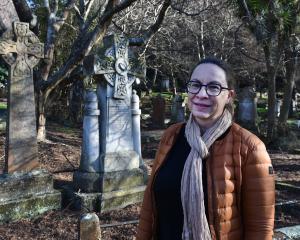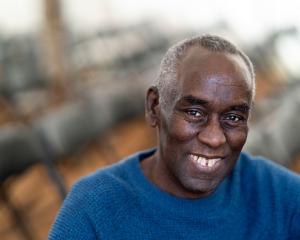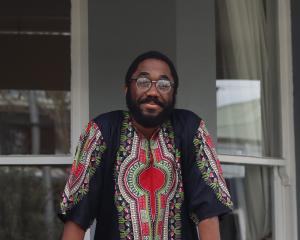Q I read, in the acknowledgments of Reach, that your new novel was inspired by a man who had parked a house-truck near your home. Please explain.
A ''I have dogs, so it was while I was walking them that I noticed this guy with a big house-truck. It's funny, that inspiration. It doesn't really suggest a story; it is more a case of a flickering image. I couldn't get rid of it.''
Q So how did you put flesh on the bones of that initial sketchy idea?
A ''It's a weird thing. With Reach, I wanted to write something that had a certain weight to it. I saw the relationships as having a fairly heavy feeling in the way they crossed over one another, but I didn't want it to get into the realm of being a desperately bleak novel. I wanted it to be a believable relationship novel without too much romance.''
Q The novel has a seaside feel, yet you don't reveal any particular place. You do, however, hint at, hmm, Wellington?
A ''Yes. Although I put a vet school in the town and also have Signal Hill vaguely in there. I thought calling it Wellington would be asking for trouble. But it is based loosely on that area around Breaker Bay as you go into Wellington harbour, that rocky coast.
''And because I had lived there for quite a long time when I was working in art galleries and museums, I was keen to set a novel in Wellington. My last couple of novels were rural, involving Alexandra and Mossburn, places like that.''
Q Still, the setting is very localised, isn't it? I mean, the characters certainly don't roam too far.
A ''Yeah. It is set in a house and the beach close to the house. There are one or two scenes in which Quinn, the artist, is shown in a gallery or Marcus, the veterinarian, is shown at work. But, really, it is about that rocky coastline.''
Q This might seem slightly presumptuous, but could there be a smidgen of your personality in the character of Quinn? By that, I'm referring to your admission, on your website and in other articles, that you like your own space, yet sometimes have to remind yourself to stop writing and re-engage with the world.
A ''Yeah, definitely. I think that has to do with being absorbed in the creative process. Other people might get absorbed in the aesthetics of a long mountainbike ride, of dodging tree roots. It's about getting lost in what you are doing. For example, you might be reading a book and, having been transported to another world, discover it's 3pm and time to get the kids from school.''
Q Can you explain your motivations for Quinn's character? She seems, at least at the beginning of Reach, to be quite difficult, remote even. Yet by the end of the book, she comes across as much more engaging than her partner, Marcus. Do you enjoy, to borrow an artistic phrase, finely etched nuances?
A ''I thought it would be easy to write a book where there was an obvious `goody' and `baddie'. But I wanted the readers' sympathies to shift as more information is fed into the novel. We learn that Marcus has left his wife and child and, though he feels this sense of loss, he has never actively tried to fix things with his daughter. He just lets things drift and thinks others are somehow responsible.
''There is also another character, Callum, the deep-sea diver who, despite being drawn to some of the coldest, darkest places on Earth, exudes a great warmth and acts as a foil to Marcus - and thus is attractive, intellectually at least, to Quinn.''
Q On the subject of characters, do you use them largely as the driving force for much of your work?
A''I think this novel is probably stronger in plot than most of my novels, but in general, after trying to set an atmosphere or location, the characters do carry the plot.''
Q In Reach, you describe saturation diving, a world of great skill and danger. You also depict, in detail, the habits of, among other things, blue cod. Likewise, the novel has no shortage of references to art. Can you explain the lengths to which you went to research these fields?A ''The art thing wasn't so difficult because I'd done art history at university. But saturation diving fascinated me. I had done my PADI introduction and went for one dive at Kaikoura in minimum visibility and got sick; I hated it so much I never thought I'd go in the water again. But I watched internet footage of saturation diving and learned how incredible it is.
''Also, I had a friend who worked at Natural History NZ in Dunedin and, when my son was young, she used to bring all these DVDs over. I think I spent two years watching natural history DVDs. Hence the reference to blue cod. You don't think you'll keep these things in your head, but, obviously, you do.''
Reach, by Laurence Fearnley, is published by Penguin ($38)
REACH AT A GLANCE. Against the backdrop of a rocky coastline, Quinn, a celebrated artist who prefers her own company to that of others, seeks refuge in her studio and on the beach as she prepares for an important exhibition. Meanwhile Marcus, an enigmatic vet who left his marriage and young daughter Audrey for Quinn, battles with issues of loyalty, love and divided responsibilities as he tries to reconcile the events of his life. As Quinn finds solace in her art and counts down the weeks to the opening of her exhibition, ''The Marriage Tomb'', Marcus retreats, seeking relief in his work and daily runs, all the while trying to find a path back to his daughter. Both he and Quinn must face challenges and make choices that will test their loyalties and have consequences for their future.
FACT FILELaurence Fearnley (51) lives in Dunedin with her husband, Dr Alex McLelland, an immunologist at the University of Otago, and son Harry (12).
Previous novels: 2010: The Hut Builder 2009: Mother's Day 2007: Edwin and Matilda 2006: Degrees of Separation 2004: Butler's Ringlet 2003: Delphine's Run 2000: Room 1998: The Sound of Her Body.
ON TOURLaurence Fearnley will read from new work and speak about her passion for writing at various libraries in the South as part of a writers' tour that also features Wellington novelist and short story writer Pip Adam, Kapiti fiction and non-fiction writer Tina Makereti and Kapiti fiction writer Lawrence Patchett. Tour datesOamaru Public Library, Thursday, October 2, 6pm Dunedin Public Library, Friday, October 3, 6pm Eastern Southland Art Gallery, Gore, Saturday, October 4, 4.30pm Te Anau Public Library, Sunday, October 5, 2pm.
Wanaka Public Library, Tuesday, October 7, 6pm ROCKYRELATIONSLaurence FearnleyPHOTOS: GREGOR RICHARDSONQ I read, in the acknowledgments of Reach, that your new novel was inspired by a man who had parked a house-truck near your home. Please explain.
A ''I have dogs, so it was while I was walking them that I noticed this guy with a big house-truck. It's funny, that inspiration. It doesn't really suggest a story; it is more a case of a flickering image. I couldn't get rid of it.''
Q So how did you put flesh on the bones of that initial sketchy idea?A ''It's a weird thing. With Reach, I wanted to write something that had a certain weight to it. I saw the relationships as having a fairly heavy feeling in the way they crossed over one another, but I didn't want it to get into the realm of being a desperately bleak novel. I wanted it to be a believable relationship novel without too much romance.''
Q The novel has a seaside feel, yet you don't reveal any particular place. You do, however, hint at, hmm, Wellington? A ''Yes. Although I put a vet school in the town and also have Signal Hill vaguely in there. I thought calling it Wellington would be asking for trouble. But it is based loosely on that area around Breaker Bay as you go into Wellington harbour, that rocky coast.
''And because I had lived there for quite a long time when I was working in art galleries and museums, I was keen to set a novel in Wellington. My last couple of novels were rural, involving Alexandra and Mossburn, places like that.''
Q Still, the setting is very localised, isn't it? I mean, the characters certainly don't roam too far.
A ''Yeah. It is set in a house and the beach close to the house. There are one or two scenes in which Quinn, the artist, is shown in a gallery or Marcus, the veterinarian, is shown at work. But, really, it is about that rocky coastline.''
Q This might seem slightly presumptuous, but could there be a smidgen of your personality in the character of Quinn? By that, I'm referring to your admission, on your website and in other articles, that you like your own space, yet sometimes have to remind yourself to stop writing and re-engage with the world.
A ''Yeah, definitely. I think that has to do with being absorbed in the creative process. Other people might get absorbed in the aesthetics of a long mountainbike ride, of dodging tree roots. It's about getting lost in what you are doing. For example, you might be reading a book and, having been transported to another world, discover it's 3pm and time to get the kids from school.''
Q Can you explain your motivations for Quinn's character? She seems, at least at the beginning of Reach, to be quite difficult, remote even. Yet by the end of the book, she comes across as much more engaging than her partner, Marcus. Do you enjoy, to borrow an artistic phrase, finely etched nuances? A ''I thought it would be easy to write a book where there was an obvious `goody' and `baddie'. But I wanted the readers' sympathies to shift as more information is fed into the novel. We learn that Marcus has left his wife and child and, though he feels this sense of loss, he has never actively tried to fix things with his daughter. He just lets things drift and thinks others are somehow responsible.
''There is also another character, Callum, the deep-sea diver who, despite being drawn to some of the coldest, darkest places on Earth, exudes a great warmth and acts as a foil to Marcus - and thus is attractive, intellectually at least, to Quinn.''
Q On the subject of characters, do you use them largely as the driving force for much of your work?A''I think this novel is probably stronger in plot than most of my novels, but in general, after trying to set an atmosphere or location, the characters do carry the plot.''
Q In
Reach, you describe saturation diving, a world of great skill and danger. You also depict, in detail, the habits of, among other things, blue cod. Likewise, the novel has no shortage of references to art. Can you explain the lengths to which you went to research these fields?A ''The art thing wasn't so difficult because I'd done art history at university. But saturation diving fascinated me. I had done my PADI introduction and went for one dive at Kaikoura in minimum visibility and got sick; I hated it so much I never thought I'd go in the water again. But I watched internet footage of saturation diving and learned how incredible it is.
''Also, I had a friend who worked at Natural History NZ in Dunedin and, when my son was young, she used to bring all these DVDs over. I think I spent two years watching natural history DVDs. Hence the reference to blue cod. You don't think you'll keep these things in your head, but, obviously, you do.''
Reach, by Laurence Fearnley, is published by Penguin ($38)
REACH AT A GLANCE. Against the backdrop of a rocky coastline, Quinn, a celebrated artist who prefers her own company to that of others, seeks refuge in her studio and on the beach as she prepares for an important exhibition. Meanwhile Marcus, an enigmatic vet who left his marriage and young daughter Audrey for Quinn, battles with issues of loyalty, love and divided responsibilities as he tries to reconcile the events of his life. As Quinn finds solace in her art and counts down the weeks to the opening of her exhibition, ''The Marriage Tomb'', Marcus retreats, seeking relief in his work and daily runs, all the while trying to find a path back to his daughter. Both he and Quinn must face challenges and make choices that will test their loyalties and have consequences for their future.
FACT FILE: Laurence Fearnley (51) lives in Dunedin with her husband, Dr Alex McLelland, an immunologist at the University of Otago, and son Harry (12).
Previous novels: 2010: The Hut Builder 2009: Mother's Day 2007: Edwin and Matilda 2006: Degrees of Separation 2004: Butler's Ringlet 2003: Delphine's Run 2000: Room 1998: The Sound of Her Body.
ON TOUR: Laurence Fearnley will read from new work and speak about her passion for writing at various libraries in the South as part of a writers' tour that also features Wellington novelist and short story writer Pip Adam, Kapiti fiction and non-fiction writer Tina Makereti and Kapiti fiction writer Lawrence Patchett.
Tour dates: Oamaru Public Library, Thursday, October 2, 6pm; Dunedin Public Library, Friday, October 3, 6pm; Eastern Southland Art Gallery, Gore, Saturday, October 4, 4.30pm; Te Anau Public Library, Sunday, October 5, 2pm; Wanaka Public Library, Tuesday, October 7, 6pm.












